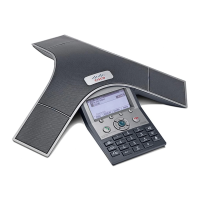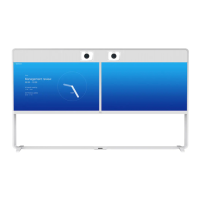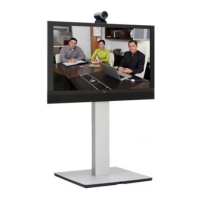D15362.06 DX70 and DX80 Administrator Guide CE9.2, NOVEMBER 2017. www.cisco.com — Copyright © 2017 Cisco Systems, Inc. All rights reserved.
89
Cisco DX70 and DX80 Administrator Guide
Network [1] QoS Diffserv ICMPv6
This setting will only take effect if Network QoS Mode is set to Diffserv.
Define which priority ICMPv6 packets should have in the IP network.
The priority for the packets ranges from 0 to 63 - the higher the number, the higher the
priority. The recommended value for ICMPv6 is 0, which means best effort. If in doubt,
contact your network administrator.
The priority set here might be overridden when packets are leaving the network controlled
by the local network administrator.
Requires user role: ADMIN, USER
Default value: 0
Value space: Integer (0..63)
Set the priority of the ICMPv6 packets in the IP network - the higher the number, the
higher the priority. The default value is 0 (best effort).
Network [1] QoS Diffserv NTP
This setting will only take effect if Network QoS Mode is set to Diffserv.
Define which priority NTP packets should have in the IP network.
The priority for the packets ranges from 0 to 63 - the higher the number, the higher the
priority. The recommended value for NTP is 0, which means best effort. If in doubt, contact
your network administrator.
The priority set here might be overridden when packets are leaving the network controlled
by the local network administrator.
Requires user role: ADMIN, USER
Default value: 0
Value space: Integer (0..63)
Set the priority of the NTP packets in the IP network - the higher the number, the higher
the priority. The default value is 0 (best effort).
Network [1] RemoteAccess Allow
Define which IP addresses (IPv4/IPv6) are allowed for remote access to the codec from
SSH/Telnet/HTTP/HTTPS. Multiple IP addresses are separated by a white space.
A network mask (IP range) is specified by <ip address>/N, where N is 1-32 for IPv4, and N
is 1-128 for IPv6. The /N is a common indication of a network mask where the first N bits
are set. Thus 192.168.0.0/24 would match any address starting with 192.168.0, since these
are the first 24 bits in the address.
Requires user role: ADMIN, USER
Default value: ""
Value space: String (0, 255)
A valid IPv4 address or IPv6 address.
Network [1] Speed
Define the Ethernet link speed. We recommend not to change from the default value,
which negotiates with the network to set the speed automatically. If you do not use
autonegotiation, make sure that the speed you choose is supported by the closest switch in
your network infrastructure.
Requires user role: ADMIN, USER
Default value: Auto
Value space: Auto/10half/10full/100half/100full/1000full
Auto: Autonegotiate link speed.
10half: Force link to 10 Mbps half-duplex.
10full: Force link to 10 Mbps full-duplex.
100half: Force link to 100 Mbps half-duplex.
100full: Force link to 100 Mbps full-duplex.
1000full: Force link to 1 Gbps full-duplex.

